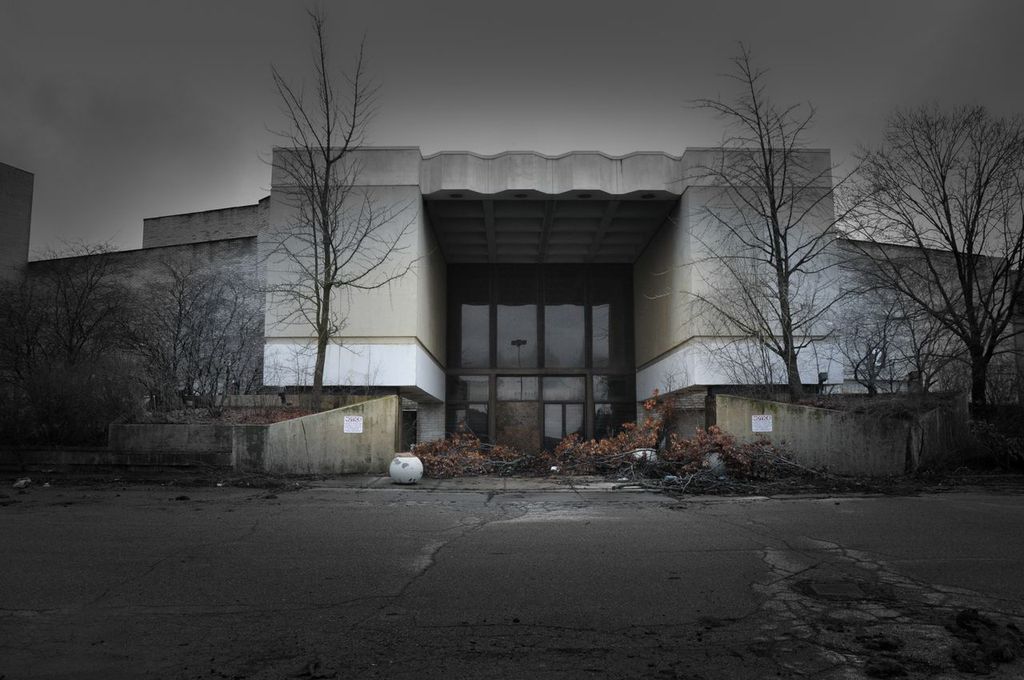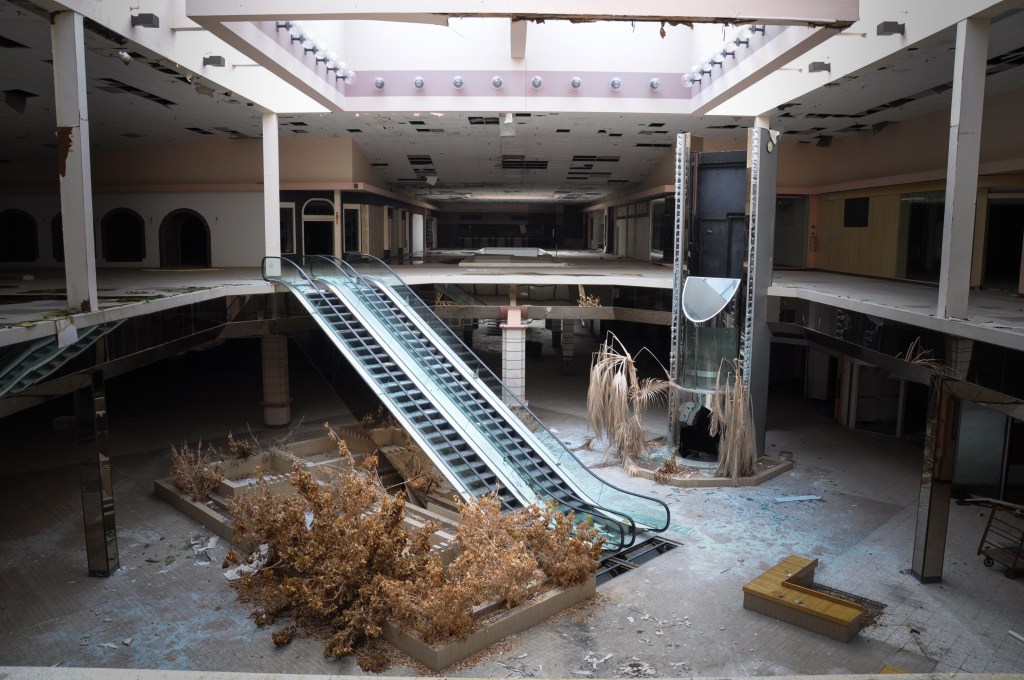
Taking Pictures Of The Dead Shopping Malls Of Our Youth: Images From Suburban America
We didn't just shop there. We communicated with people there. Before there was social media you actually went out and talked to people. The mall played an intricate part of that process in our society.

Online eulogies for America’s vacant shopping malls are nothing new. Deadmalls.com, for example, the oft-cited authority on the ill-fated pleasure domes that dot the 50 states, has been operating since the turn of the century, going live as the rampant fear over Y2K still lingered in the nation’s collective memory. And while the legions of shuttered malls filed in the site’s archives have only grown larger over the last decade and a half, the practice of photographing and reminiscing about the dead malls where many of us spent our youth has become a rather ubiquitous form of shared nostalgia in our online lives. That same retail-centric nostalgia also acts as a salient reminder of the shopping mall’s endangered status as a once-indispensable fixture of suburban life.



In his new book, Black Friday: The Collapse of the American Shopping Mall, Cleveland-based photographer Seph Lawless documents the fate of two Ohio shopping malls that became casualties of the Great Recession — Rolling Acres Mall in Akron, closed in 2008; and Randall Park Mall in North Randall, closed in 2009. Continuing the work that he began in his first photo book, Autopsy of America (2013), which examined the impact of globalization on American cities, Black Friday offers a more targeted and personalized view of those same economic ripple effects. After all, Rolling Acres and Randall Park were the malls Lawless visited as a child and where he eventually worked his first job as a teenager.
“People have good memories at these malls,” says Lawless. “We didn’t just shop there. We communicated with people there. Before there was social media you actually went out and talked to people. The mall played an intricate part of that process in our society.”


Lawless, who considers himself both an artist and an activist, has gained a considerable following for his work in recent years. Thanks in part to a dominant presence on social media, particularly Facebook and Instagram, Lawless uses his platform to champion causes that he believes in — namely hunger relief efforts both domestically and internationally. I recently spoke with Lawless regarding his book Black Friday, the plight of America’s economically impoverished cities, and the appeal of photographing modern ruins.
Thought Catalog: What prompted your interest in abandoned shopping malls as subject matter?
Seph Lawless: In 2013, I started the project Autopsy of America, traveling all over America photographing the most abandoned parts of my country. I photographed everything from abandoned homes, hospitals, factories, schools, and basically entire abandoned cities in America. It was during this project that I came across shopping malls and I knew it would be a powerful symbol to portray an abandoned shopping mall. I knew it could deeply impact the viewer, so I shifted to that topic for my next book, which was Black Friday: The Collapse of the American Shopping Mall.
TC: Aside from the fact that they were each derelict buildings, what attracted you to Rolling Acres Mall and Randall Park Mall?
SL: Mainly social relevance and personal experience. I went to both these malls growing up as a child of the 70s and early 80s. Both malls opened in the mid to late 70s and Randall Park opened as the largest shopping mall in the entire world in 1978. Both malls were slated for demolition and Randall has started the demolition process, so to me it was a timely topic for several reasons.

TC: How did being from Cleveland, and knowing the city’s history, inform your point of view for this book?
SL: I think witnessing the effects of globalization and watching manufacturing jobs being shipped overseas essentially my whole entire life impacted how I view the world and my city. It was devastating and it resulted in massive population loss and it is still affecting us.
TC: Photographs of abandoned shopping malls often evoke a visceral response from the public. This is especially true when the person viewing the photographs is intimately familiar with the mall, having visited often as a child or teenager. What type of response, positive or negative, have the photographs in Black Friday elicited?
SL: The response has been overwhelming. It was orchestrated that way by design, but I never anticipated a global response to this project. It was essentially aimed at Americans and I never anticipated such a response outside of this country. Most of the responses I get are generally positive. People have good memories at these malls. We didn’t just shop there. We communicated with people there. Before there was social media you actually went out and talked to people. The mall played an intricate part of that process in our society. Based on the response from my work, I soon realized that people just didn’t miss the malls. They missed everything that was connected to it. In a way, they missed America.

TC: The decline of the American shopping mall is often pinned to a number of factors. Some see it as the result of a changing economy that can no longer sustain these large, retail-centric facilities. Others view its decline as a flawed and unsustainable vision of suburban planning. What’s your impression?
SL: There’s a huge disconnect between most Americans and the reality of what is really happening to the American economy. Yes, there’s several reasons why malls fail. From poor planning to online shopping and so on, but the high-end malls are thriving. This really has nothing to do with any of that. These malls that I photograph are usually the last things to go in a community. You go outside and all the stores outside are abandoned. The gas stations, fast food chains, and the neighborhoods like ghost towns. It’s incredibly shortsighted to look at my images and say that’s a mall in a thriving suburb, when the reality is it’s a failed mall in a town that looks like a bomb hit it. This project has taught me that Americans are even more disconnected than I ever anticipated.
TC: You’ve been donating all proceeds from the sale of the book to the Ohio Association of Foodbanks. Can you give some insight on what prompted that decision?
SL: I donate proceeds from anything I sell from my site and have been a strong supporter of Feed the Children and the Ohio Food Banks. I will be donating all proceeds of an ebook being released in June specifically to raise money for Feed the Children. Several people have really helped to make this happen and we hope to really encourage people to use social media to create a social change. Not just a substantial social change, but a sustainable change.
The reason I partnered with charitable organizations started after going into the most abandoned and broken parts of this country during my project Autopsy of America and seeing that people were still living there. They were alone and forgotten. You can’t help to be moved and want to help. You wouldn’t believe the conditions they live in. It’s like you’re in a third world country. You see the children and just emotionally break down. They deserve better. If my images can spread awareness about these areas of the country and the issues that are affecting these Americans that still live there then it’s a viable option for me to help the only way I know how. Through the use of art and creativity.

TC: You mention that several people have helped to make this happen. Are you referring to money raised through the sale of the book? Or is the work that you do supported in other ways as well (i.e., grants, private donations, etc.)?
SL: Soon I will be setting up kiosks at a few local suburban malls near the abandoned malls that were in Black Friday. I will be selling prints and books with all proceeds going to the Ohio Food Bank. Everyone from the participating mall staff and the Ohio Food Bank helped make that happen. I went to them with that idea and they gave me their full support. We anticipate a great response over a weekend long fundraising drive in July, and, if it goes well, we will be doing it more often.
TC: When you say you visited the “most abandoned and broken parts of this country,” can you give examples of particular cities or neighborhoods where the living conditions left the greatest impression?
SL: Gary, Indiana is a particular city that was really emotional. There’s just a heaviness that settles there. I always get emotional there because the void and emptiness is just so deep and overwhelming. Beyond that Detroit, East Cleveland, Toledo, Akron, Youngstown, and Buffalo all represent some of the most poor and disenfranchised Americans in the country. ![]()






